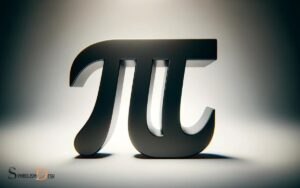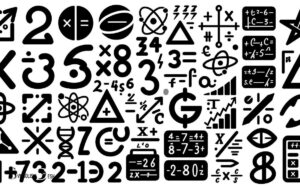Symbols in Math and Their Meaning: Equals!
Mathematics is replete with a variety of symbols, each with a distinct meaning, contributing to the concise communication of complex ideas.
Symbols such as + (plus), – (minus), = (equals), and / (divide) represent fundamental operations, whereas π (pi), √ (square root), and i (the imaginary unit) transcend basic arithmetic, embodying profound concepts in geometry and complex analysis.
Understanding these symbols is essential for mastering mathematical principles and solving problems efficiently.
Symbols serve as the shorthand of mathematics, allowing mathematicians and students to write more complex expressions in a readable and universally understood form. Symbols like “+”, “=”, and “π” streamline communication, enabling the efficient exchange of ideas across different languages and disciplines. Among these, the “there exists symbol in math,” denoted by ∃, is particularly important in mathematical logic and proofs, representing the existence of at least one element satisfying a given condition. Such symbols not only simplify notation but also elevate the precision and elegance of mathematical discourse.
Here’s a closer look:
For example, the equation √(x^2) = |x| uses the square root symbol and the absolute value symbol to express a fundamental property of square roots in relation to positive and negative numbers.
Embracing the language of math through its symbols not only streamlines communication but also unlocks the door to advanced concepts, showcasing the elegance of mathematical thought.

Key Takeaway
The Meaning of Basic Arithmetic Symbols
The basic arithmetic symbols, such as addition, subtraction, multiplication, and division, are fundamental to understanding mathematical operations.
Addition, represented by the symbol ‘+’, combines two or more numbers to find their total. Subtraction, denoted by ‘−’, involves finding the difference between two numbers.
Multiplication, symbolized by ‘×’ or ’*‘, signifies repeated addition of a number. Division, represented by’÷’ or ‘/’, indicates the sharing or grouping of a quantity into equal parts.
These symbols form the cornerstone of elementary mathematical operations and are essential for problem-solving in everyday life.
Understanding their meanings and applications is crucial for building a strong foundation in mathematics.
Exploring Algebraic Symbols and Their Significance
Algebra’s symbolic representation of mathematical relationships plays a significant role in problem-solving and expressing quantitative connections.
In algebra, symbols are used to represent variables, constants, and operations, allowing for the manipulation and analysis of mathematical expressions and equations.
Understanding these symbols is crucial for mastering algebraic concepts and solving complex problems.
The table below provides a concise summary of some common algebraic symbols and their meanings:
| Symbol | Meaning |
|---|---|
| x | Variable |
| y | Variable |
| a | Constant |
| b | Constant |
| + | Addition |
| – | Subtraction |
| * | Multiplication |
| / | Division |
| = | Equality |
This table serves as a useful reference for navigating algebraic expressions and understanding the significance of each symbol in mathematical contexts.
Understanding the Symbols of Geometry and Their Applications
An understanding of geometric symbols and their practical applications is essential for effectively communicating and analyzing geometric concepts.
Geometry symbols serve as a language to represent various elements and properties of shapes, angles, and spatial relationships.
Here are some key geometric symbols and their applications:
- ∠: Represents an angle, its measurement, and relationships between angles.
- Δ: Denotes a triangle, its sides, angles, and properties.
- ⊥: Indicates perpendicular lines or the perpendicularity of line segments.
- ∥: Signifies parallel lines or the parallelism of line segments.
- π: Represents the mathematical constant pi, essential for calculations involving circles and spheres.
Understanding and utilizing these symbols facilitate clear and concise communication in geometric reasoning and problem-solving.
Delving Into the Symbols of Calculus and Their Functions
The study of calculus involves the use of various mathematical symbols to represent key concepts and operations.
These symbolic notations are essential for expressing functions, derivatives, integrals, and other fundamental principles in calculus.
Understanding the functions and meanings of these symbols is crucial for mastering the language of calculus and applying it to solve real-world problems.
Symbolic Notations in Calculus
Exploring the symbolic notations in calculus reveals the precise language used to express the fundamental concepts and operations in this branch of mathematics. In this intricate field, symbols play a crucial role in representing various mathematical ideas and relationships.
Here are some key symbolic notations used in calculus:
- Derivative Notation: The prime symbol (’) and Leibniz’s notation (dy/dx) represent derivatives.
- Integral Notation: The integral symbol (∫) denotes the process of finding antiderivatives and computing areas.
- Limit Notation: The use of the limit symbol (lim) signifies the behavior of functions as they approach certain values.
- Summation Notation: The summation symbol (Σ) is employed to succinctly represent the sum of a sequence.
- Function Notation: Utilizing f(x) to denote a function allows for concise representation of input-output relationships.
Understanding these symbolic notations is essential for mastering the language of calculus and its applications in solving real-world problems.
Functions of Mathematical Symbols
Delving into the functions of mathematical symbols in calculus reveals their essential roles in representing and manipulating fundamental mathematical relationships.
In calculus, symbols such as ∫ (integral), d/dx (differentiation), and Σ (summation) are pivotal in expressing complex mathematical concepts succinctly.
The integral symbol, for instance, signifies the accumulation of quantities, while the derivative symbol represents the rate of change.
These symbols enable the concise representation of intricate mathematical operations and relationships, allowing for the analysis of functions and their behavior.
Understanding the functions of these symbols provides a foundation for comprehending the principles of calculus and their application in solving real-world problems.
As we unravel the symbols of statistics and their interpretations, it becomes evident that mathematical notation plays a crucial role in various branches of mathematics, facilitating the expression and analysis of diverse mathematical phenomena.
Unraveling the Symbols of Statistics and Their Interpretations
Upon delving into the field of statistics, one encounters a myriad of symbols that hold distinct meanings and interpretations. Understanding these symbols is crucial for interpreting and analyzing statistical data effectively.
To shed light on this complex subject, we will unravel the symbols of statistics and their interpretations.
- Mean (µ): Represents the average of a set of numbers.
- Standard Deviation (σ): Indicates the extent of deviation for a set of values from their mean.
- Correlation Coefficient (r): Denotes the strength and direction of a linear relationship between two variables.
- Probability (P): Signifies the likelihood of a specific event occurring.
- Sample Size (n): Refers to the number of observations or individuals in a sample.
Understanding these symbols is fundamental for mastering statistical concepts and drawing meaningful conclusions from data.
The Role of Symbols in Mathematical Notation and Communication
As mathematical language evolves, the role of symbols in mathematical notation and communication remains pivotal, facilitating precise and concise expression of complex mathematical concepts.
Symbols serve as a universal language, transcending linguistic barriers and allowing mathematicians worldwide to communicate ideas effectively.
They condense lengthy explanations into compact representations, saving time and space in written and spoken discourse.
Moreover, symbols enable the abstraction of general principles, making it easier to discern patterns and relationships within mathematical systems.
Through standardized symbols, mathematicians can convey intricate ideas with clarity and efficiency, fostering a deeper understanding of mathematical concepts.
As such, the role of symbols in mathematical notation and communication is indispensable, serving as a cornerstone of mathematical discourse and enabling the seamless transmission of mathematical knowledge across generations and cultures.
Symbolic Representations in Mathematical Logic and Set Theory
Symbolic representations play a crucial role in mathematical logic and set theory, providing concise and precise ways to express complex mathematical concepts.
In mathematical logic and set theory, symbols are used to represent various elements and operations, aiding in the formulation and manipulation of mathematical statements and theories.
Some important symbolic representations in mathematical logic and set theory include:
- Logical connectives such as ¬ (negation), ∧ (conjunction), ∨ (disjunction), → (implication), and ↔ (biconditional).
- Quantifiers like ∀ (universal quantifier) and ∃ (existential quantifier).
- Set notation symbols such as ∈ (element of), ∪ (union), ∩ (intersection), and ∅ (empty set).
- Symbols for relations, including = (equality) and ∈ (subset).
- Operators like ∩ (intersection), ∪ (union), and complement (¬).
These symbols enable mathematicians to succinctly represent complex concepts and relationships, facilitating the development and communication of mathematical theories and proofs.
The Symbolism of Specialized Mathematical Fields
The symbolism of specialized mathematical fields encompasses a diverse range of concepts and representations.
From the intricate algebraic structures to the significance of Greek letters and the symbols used in statistical analysis, each area offers unique insights into the language of mathematics.
Exploring the symbolism of points in these specialized fields provides a deeper understanding of their applications and implications within the broader mathematical framework.
Symbolism in Algebraic Structures
Algebraic structures’ symbolism in specialized mathematical fields plays a crucial role in representing relationships and operations with precision and abstraction.
In the realm of algebraic structures, symbolism takes on various forms to convey complex mathematical concepts.
This includes:
- Groups: Employing symbols to represent the operations of a group, such as addition modulo n.
- Rings: Using symbols to illustrate the operations of addition and multiplication within a ring.
- Fields: Symbolically denoting the operations of addition, subtraction, multiplication, and division in fields.
- Vector Spaces: Utilizing symbols to depict the operations and relationships within vector spaces.
- Lattices: Employing symbols to represent the ordering and structure of elements in a lattice.
Understanding these symbolic representations is fundamental for grasping the intricacies of algebraic structures and their applications in various mathematical fields. This leads us to explore the significance of Greek letters in mathematics.
Significance of Greek Letters
Greek letters play a significant role in conveying precise mathematical symbolism within specialized mathematical fields.
For instance, in calculus, the Greek letter delta (∆) is used to represent a change in a variable, while in trigonometry, the Greek letter theta (θ) commonly denotes an angle.
Moreover, in physics, the Greek letter pi (π) is used to represent the mathematical constant that defines the ratio of a circle’s circumference to its diameter.
Each Greek letter holds specific meaning and significance within its respective mathematical discipline, allowing for clear and consistent representation of mathematical concepts.
Understanding the symbolism of Greek letters is paramount in grasping the intricate language of mathematics and its various branches.
Symbols in Statistical Analysis
Continuing from the previous subtopic, symbols in statistical analysis serve as essential tools for conveying precise mathematical concepts within specialized fields of study.
In statistical analysis, symbols play a crucial role in representing various parameters, measures, and operations.
Here are some key symbols used in statistical analysis:
- μ (Mu): Represents the population mean
- σ (Sigma): Denotes the population standard deviation
- Σ (Capital Sigma): Indicates summation in a series
- β (Beta): Represents the slope of the regression line
- ρ (Rho): Denotes the population correlation coefficient
Understanding and interpreting these symbols is fundamental for comprehending statistical models, making inferences, and drawing conclusions in fields such as economics, psychology, and biology.
Their significance lies in providing a standardized language for conveying complex statistical relationships.
Conclusion
In the vast landscape of mathematics, symbols serve as the language through which the mysteries of the universe are unraveled.
Like the notes of a symphony, each symbol plays a crucial role in the composition of mathematical understanding.
From the simplicity of basic arithmetic to the complexity of specialized fields, the symbolic language of mathematics guides us through the intricate maze of numbers and shapes, revealing the beauty and order hidden within.






